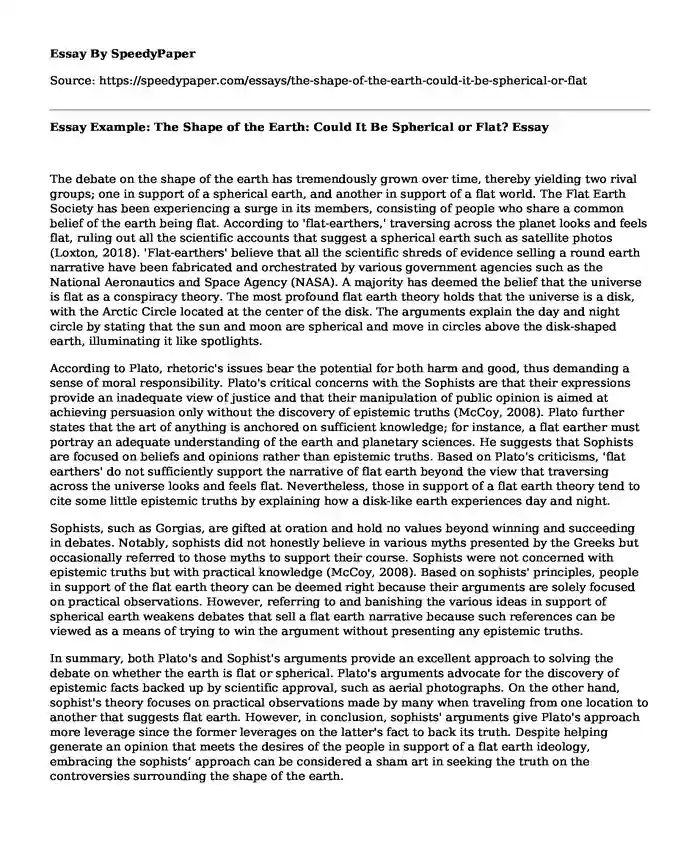The debate on the shape of the earth has tremendously grown over time, thereby yielding two rival groups; one in support of a spherical earth, and another in support of a flat world. The Flat Earth Society has been experiencing a surge in its members, consisting of people who share a common belief of the earth being flat. According to 'flat-earthers,' traversing across the planet looks and feels flat, ruling out all the scientific accounts that suggest a spherical earth such as satellite photos (Loxton, 2018). 'Flat-earthers' believe that all the scientific shreds of evidence selling a round earth narrative have been fabricated and orchestrated by various government agencies such as the National Aeronautics and Space Agency (NASA). A majority has deemed the belief that the universe is flat as a conspiracy theory. The most profound flat earth theory holds that the universe is a disk, with the Arctic Circle located at the center of the disk. The arguments explain the day and night circle by stating that the sun and moon are spherical and move in circles above the disk-shaped earth, illuminating it like spotlights.
According to Plato, rhetoric's issues bear the potential for both harm and good, thus demanding a sense of moral responsibility. Plato's critical concerns with the Sophists are that their expressions provide an inadequate view of justice and that their manipulation of public opinion is aimed at achieving persuasion only without the discovery of epistemic truths (McCoy, 2008). Plato further states that the art of anything is anchored on sufficient knowledge; for instance, a flat earther must portray an adequate understanding of the earth and planetary sciences. He suggests that Sophists are focused on beliefs and opinions rather than epistemic truths. Based on Plato's criticisms, 'flat earthers' do not sufficiently support the narrative of flat earth beyond the view that traversing across the universe looks and feels flat. Nevertheless, those in support of a flat earth theory tend to cite some little epistemic truths by explaining how a disk-like earth experiences day and night.
Sophists, such as Gorgias, are gifted at oration and hold no values beyond winning and succeeding in debates. Notably, sophists did not honestly believe in various myths presented by the Greeks but occasionally referred to those myths to support their course. Sophists were not concerned with epistemic truths but with practical knowledge (McCoy, 2008). Based on sophists' principles, people in support of the flat earth theory can be deemed right because their arguments are solely focused on practical observations. However, referring to and banishing the various ideas in support of spherical earth weakens debates that sell a flat earth narrative because such references can be viewed as a means of trying to win the argument without presenting any epistemic truths.
In summary, both Plato's and Sophist's arguments provide an excellent approach to solving the debate on whether the earth is flat or spherical. Plato's arguments advocate for the discovery of epistemic facts backed up by scientific approval, such as aerial photographs. On the other hand, sophist's theory focuses on practical observations made by many when traveling from one location to another that suggests flat earth. However, in conclusion, sophists' arguments give Plato's approach more leverage since the former leverages on the latter's fact to back its truth. Despite helping generate an opinion that meets the desires of the people in support of a flat earth ideology, embracing the sophists’ approach can be considered a sham art in seeking the truth on the controversies surrounding the shape of the earth.
References
Loxton, D. (2018). Is the Earth Flat? Flat Earthers Are Back--You Know the Earth Is Round, But How do You Best Make the Argument? Skeptic (Altadena, CA), 23(2), 8-14. https://iopscience.iop.org/article/10.1088/1361-6552/aac053/meta.
McCoy, M. (2008). Plato on the rhetoric of philosophers and sophists. Cambridge University Press.
Cite this page
Essay Example: The Shape of the Earth: Could It Be Spherical or Flat?. (2023, Nov 27). Retrieved from https://speedypaper.com/essays/the-shape-of-the-earth-could-it-be-spherical-or-flat
Request Removal
If you are the original author of this essay and no longer wish to have it published on the SpeedyPaper website, please click below to request its removal:
- Requirement of Being a Good Student, Free Essay in Education
- Free Essay Example Dedicated to James Joule Prescott
- Free Essay Sample on Hydrogen Cyanide Handling and Safety Measures
- Free Essay. History and Future of Sports Car Doors Evolution
- Free Essay: Scientific Map Freshwater Transport in the Arctic Ocean
- Free Paper Sample on Transport Industry
- Report on Leadership Insights: Nehemiah's Strategy, Ezra's Teachings, and Personal Contribution Impact
Popular categories





